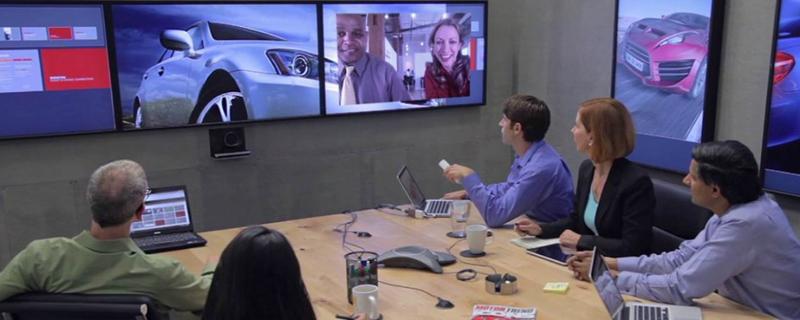Our Collaborative Computing Future: Oblong’s Mezzanine
When people think of futuristic user interfaces (Forrester analysts included), they often invoke the 2002 Tom Cruise movie Minority Report. The imagery in the movie offers a compelling vision of how next-generation technologies – gestural control, voice command, 3D visuals, multi-screen interactions – can empower computing experiences.
Where did Minority Report get this vision? From a man named John Underkoffler, Chief Scientist at a company called Oblong. He designed the computer interfaces in the film.

I had the pleasure of visiting Oblong’s Boston office recently, where I saw demonstrations of several technologies. Most interesting to me was the company’s Mezzanine offering, an “infopresence” conference room that the company sells to enterprises today.
The solution involves equipping a conference room (or multiples – it works as a long distance telepresence location) with a number of monitors (5 in the room I visited), teleconferencing equipment (industry standard products work well), and ceiling-mounted sensors (for interpreting gestural controls), and a whiteboard (a physical one, but visible to a camera). Workers control the room with a wand, which works via both gestural controls and a button.
Putting all of these things together, workers can collaborate both within the room itself and with remote teams (or remote individual team members). The resulting experience, in my view, offers two sets of benefits:
Mezzanine helps employees take better advantage of data. Most workplaces are swimming in various forms of data, some (or much) of which never gets used effectively. Oblong’s solution helps workers by:
- Making the most of data assets. In a typical meeting at most companies, employees pass the HDMI or VGA cable between laptops to share different screens. With Mezzanine, multiple images can be (usefully) referenced off of multiple devices (across platforms). Rather than being stuck on a single PowerPoint, for instance, the collaborative meeting could reference a PowerPoint, a live web page, a data visualization, and other sources that might not get used in the meeting at all. Finally, certain assets can be “parked” on side screens (for example, reference diagrams, photos, or data points) to retain a presence in the meeting.
- Creation of new meeting-derived artifacts. All the assets (again, PowerPoints, specific web pages, data charts, visuals) can be saved into “dossiers,” which represent a new type of artifact created during a meeting. These dossiers bring together relevant data and insights from various sources – assembled collaboratively during the meeting.

Mezzanine also represents a new type of collaborative computing. Ultimately, the collaboration possible with these solution reprograms the way colleagues work together. (A related case is a sales win room that allows salespeople to collaborate with their prospects and customers). This involves:
- Weaving telepresence into the data-rich meeting. Telepresence has its boosters, but it’s only replicating a face to face experience (and not very well). Telepresence plus collaborative computing, as with Mezzanine, makes a whole lot more sense. The visual cues of telepresence promote better human interaction, but it’s the collaborative computing that’s adding the ultimate value.
- Redesigning how people work together. Mezzanine can help roduct design teams, architects, sales teams, various other types of information workers increase their productivity and creativity. And it’s the latter – creativity – that seems best linked to innovation. If these techniques work as well as they appear to, the ROI on what can be an expensive up-front investment would be largely positive.
In the future, it would be easy to see some of the larger industry vendors (like Samsung, which has prowess in digital displays, whiteboards, and teleconferencing equipment, or Microsoft, which has assets in collaboration through Sharepoint and videoconferencing via Skype) either replicating some of the capabilities of Mezzanine or purchasing Oblong outright. For now, Oblong offers a high-end, differentiated solution for collaborative computing that brings Minority Report flash to the workplace – with a much more tangible result.
